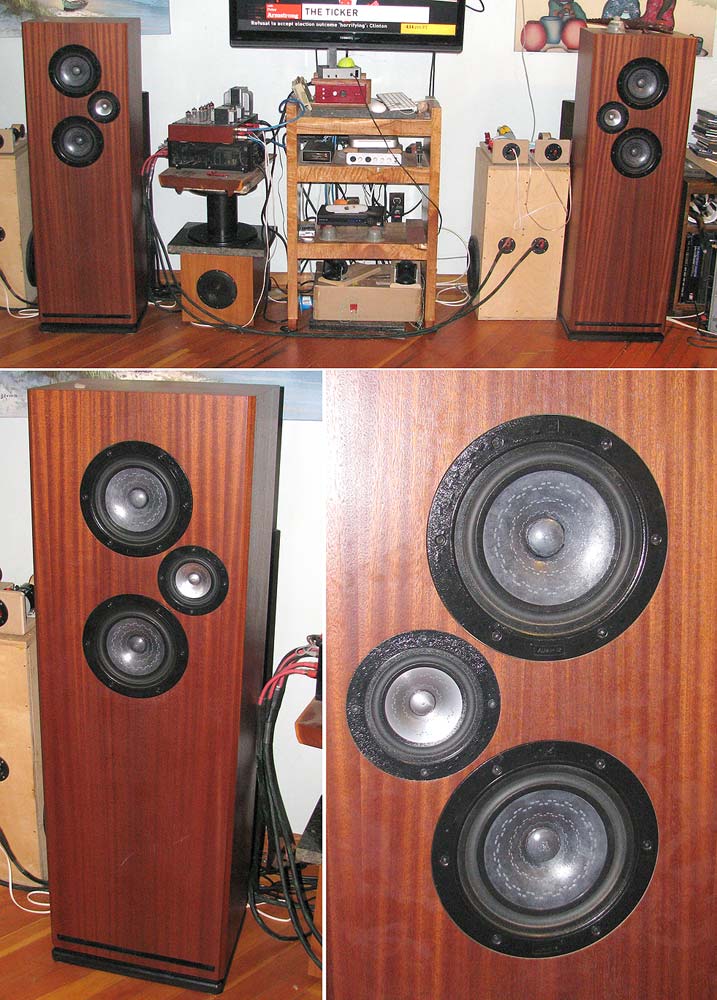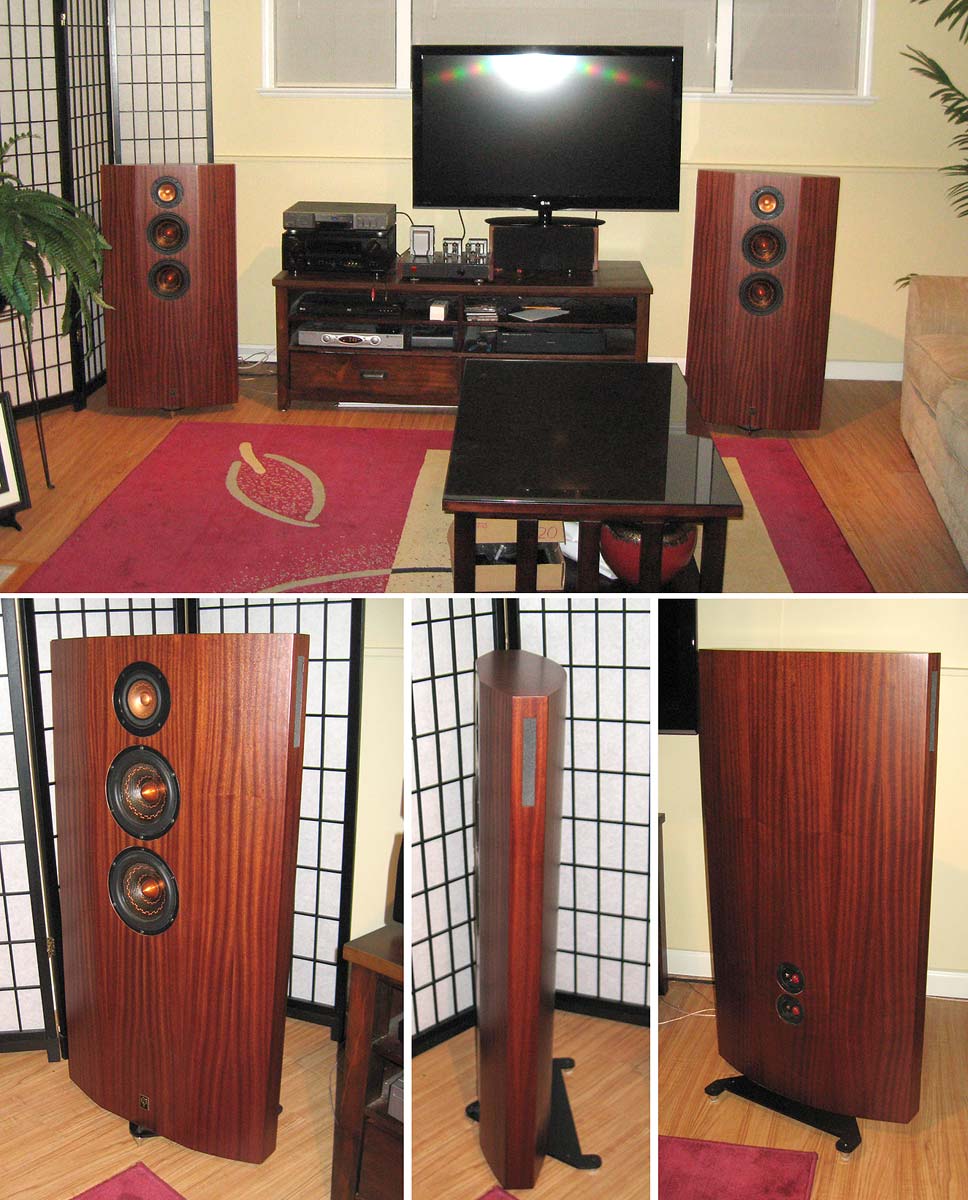I'm having trouble finding anything smaller than 5 inch.
I have had good luck with a number of quality 3 and 4”, now i do not add a tweeter — no way to get the driver spacing close enuff to give an XO a big edge. And a tweeter often just mucks things up.
dave
My silly thoughts, what's the point of having a very fast mids, in the end wouldn't there be a need to find a woofer that manages the same speed to create a proper synergy ?
Try using a Heil AMT tweeter crossed down to 700Hz. Almost midrange. It has almost no membrane mass - and Newton’s 2nd law would say that it can accelerate faster than a membrane with more mass. It sounds very nice, clear and transparent.
When played as a midrange - with female vocals and holding the tweeter in my hand, it felt like a miniature version of the singles was magically shrunken down a la Alice in Wonderland and placed at the tweeter aperture. Very realistic.
Not having Heil AMT, my next choice would be ScanSpeak 10F operated above 400Hz.
When played as a midrange - with female vocals and holding the tweeter in my hand, it felt like a miniature version of the singles was magically shrunken down a la Alice in Wonderland and placed at the tweeter aperture. Very realistic.
Not having Heil AMT, my next choice would be ScanSpeak 10F operated above 400Hz.
Try using a Heil AMT tweeter crossed down to 700Hz. Almost midrange. It has almost no membrane mass - and Newton’s 2nd law would say that it can accelerate faster than a membrane with more mass. It sounds very nice, clear and transparent.
When played as a midrange - with female vocals and holding the tweeter in my hand, it felt like a miniature version of the singles was magically shrunken down a la Alice in Wonderland and placed at the tweeter aperture. Very realistic.
Not having Heil AMT, my next choice would be ScanSpeak 10F operated above 400Hz.
AMT tweeter crossed at 700 Hz and that Newtons idea is the reason for starting this thread. I figured, it must have been its low mass that causes that natural sound to it.
If it goes down to 700 Hz and, since it's a folded ribbon, it would most likely require a very steep crossover. I'm not sure whether going with a more complex crossover is a solution. After all, it takes years for people to do it right. And then there goes it's problems with a narrow vertical dispersion and placing it close enough to low range drivers.
Though, Mark Daniels monitors sounded very good.
Yep since the beginning it is a filter and amp question more. People want loudspeakers than can handle fast dynamic gaps while the recordings are more and more compressed.
Making rhe group delay clean between the mid and the tweeter should be enough to answer to the question...below the Schroeder frequency so bass driver it is more trickyt but nothing impossible for a good enough quality.
Could you explain a bit further that group delay and crossing below Schroeder frequency?
Have you ever thought it odd that all the letters he opens are in identical blank envelopes?
No, but I found very odd that obsession of his with dog figures (that cost as a very good woofer, a big one)
I have had good luck with a number of quality 3 and 4”, now i do not add a tweeter — no way to get the driver spacing close enuff to give an XO a big edge. And a tweeter often just mucks things up.
dave
I think I'm going to steal your idea. It would be easier to place two drivers closer together on much lower frequency. Both paper cones, so similar sound signature. A full range that would do it all, so there's less chance to screw the crossover design. Less problems with vertical dispersion. Maybe that sonido you commented on another thread.
Something else to keep in mind??
I think I'm going to steal your idea. It would be easier to place two drivers closer together on much lower frequency. Both paper cones, so similar sound signature. A full range that would do it all, so there's less chance to screw the crossover design. Less problems with vertical dispersion. Maybe that sonido you commented on another thread.
Something else to keep in mind??
Once releaved of the bass, a FR used in a WAW (Woofer Assisted Wideband) have to work much less which imroves their midTop.
There are many suitable FRs for use as midTweeter. The Scan X mentions (use the cheaper one, the 10F X usually uses has deficient top (Scan calls it a midrange)
I have used Fostex FF85k/FF85wk and Mark Audio A7x and A5.2 with good success.
Here are 2 of the biggest we have done. It is worth noting they have the same midTweeter, the closer sonic signature of the MArk Audio bass driver mated better than the “CF” SDX7. They are both outstanding.


You will find a growing nyumber of designs as peopel start to explore this approach in ernest. Curt’s Halcyon, for instandce, has been getting some good traffic.
dave
No. Or the frequencies it reproduces would be midrange. 😉
I believe it's difficult to understand these notions of speed related to the length of the wave length and the motion involved to play it at a given spl (the speed related to the voice coil elongation in its linear behavior to reach those spl.
Again the little cone will move faster to run the distance allowed to reach a given spl than the bigger cone, but both will reach the spl in the reccording in the limit of what can handle the amp and the thermalcompression of the driver and its mechanical limits for the littliest sized one. Then the music if the power response is flat will reach the ears at the same speed which is the speed of sound in air : more or less 343/4 m/s. Maybe I didn't understand but this is my actual knowledge related to the speed of a driver and I remember some time ago 5th Element heped me to understand that already ith these story of wave lengths/speed when the frequencies increase. I hope I understood correctly.
Most do not understand than the voice coil will move fast enough related to its size and only the damping and thermal compression may be a problem when the size of the cone is too little related to some spl it must playback.
Sumotan asked an important question as I know he is an ESL owner. How some bass cabinet can "follow" a big Sd ESL that moves little without having group delay loss ? Some can play a square wave though music is not a standalone square wave and music have superseeded frequencies to playback and harmonics while drivers are breaking their surface in complex behavior at trying to play it the best they can. My understanding is more drivers with shorter voice coil is a better theorical answer but hen come the delay problem introduced when you increase the number of filter ways... Shortest answer, buy an ESL loudspeaker !
Martin Logan answered by servo subs with cardioid DSP behavior, the rear woofer firering towards the front wall is delayed by DSP and also with the filter delay it's certainly gives a greater readness of the frequencies involved and a greater mariage between this difficult marriage between an ESL diagphragm and a bass cone. This better readness can a subjective feeling of fastness while not loading too much the room at some frequencies due t the room gain.
At least my understanding.
Last edited:
The OP is probably trying to say "transient response", not very sure though.
perhaps fast decay, as seen on waterfall plot?
Again the little cone will move faster to run the distance allowed to reach a given spl than the bigger cone
That is not a given. You need to know the application and take into consideration the motor. The lighter cone will get away with a smaller motor.
dave
My silly thoughts, what's the point of having a very fast mids, in the end wouldn't there be a need to find a woofer that manages the same speed to create a proper synergy ?
If the group delay of the woofer copes with the one of the midrange in a fine filter then one will have nearly no problems. Basicly with many comercial designs that are not expensive flagship cause the brands know how t make it fine, often you have your mid and tweet that plays before the driver below... few micro seconds (because the filter, the layout of the drivers in the bafle, etc) : it's enough to make sometimes your music not "FAST Coherent". So you beleive than the bass driver or the midrange is involved and instead it's the design, the filter...
Easy answer is an active design with DSP but you like I are not too much active filter involved, we like too much our amps and classic DAC to hassle with an ADC/DAC conversion and active amps !
Trade offs !
That is not a given. You need to know the application and take into consideration the motor. The lighter cone will get away with a smaller motor.
dave
More exactly it's the ratio weight/motor, but I believe my reasoning is right when the spl becomes greater and the little cone will have more problems at playing some spl peaks (call that dynamic peaks) and little movements in the same time for playing lowest spl levels notes in the same time windows, not talking harmonics in the same time.... Physic is physic I believe the smallest Sd will suffer more and their cone if low Sd will break in all directions with phase rotation at the surface and so on ! Big Sd, low elongation wins ! Hence ESL... and twice as they are full range as well ! Y'a pas photo !
Last edited:
perhaps fast decay, as seen on waterfall plot?
To a point, but when you put a low-pass on it, many of the effects can clean up & you're simply left with artifacts of the filtering & any relevant gating window; John Krutke gave a short illustration of that a few years ago on his site.
More exactly it's the ratio weigth/motor,
Are you talking about the long-exploded myth of acceleration factor (as in [B*L] / Mms in SI units giving a nominal value in meters per second per second per ampere)?
Within the piston BW it's twaddle, simply being another way of expressing efficiency. In any relevant TL operating region it may give an idea as to ultimate HF extension, but even then it may not, since it ignores any mechanical decoupling of portions of the cone from the coil, nor does it give any idea how much of that might actually be usable.
What did you mean by this then?
From the rest, it appears you are suggesting that the larger the drive unit, the 'faster' it will be at a given frequency, which I'm afraid, for all the undoubted merits of large drive units, isn't the case.
More exactly it's the ratio weight/motor,
From the rest, it appears you are suggesting that the larger the drive unit, the 'faster' it will be at a given frequency, which I'm afraid, for all the undoubted merits of large drive units, isn't the case.
- Home
- Loudspeakers
- Multi-Way
- Fast midrange driver